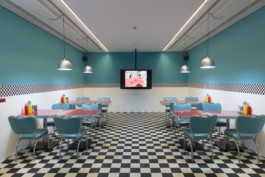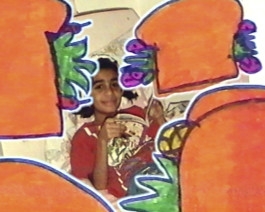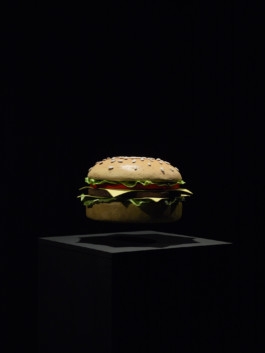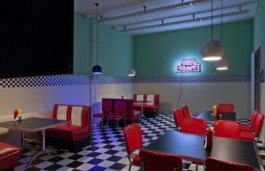





2017, Video installation, Video, 16 min.
The Craft
Housed in the obsolete atmosphere of an artificially constructed American diner, The Craft is a film that revolves around childish fictions laced with serious suspicions towards the real world. Using the lens of family history, the film dissects the artist’s own past to reexamine an uncanny relationship taking place in the shadows of her major life events: “Were my parents conspiring with aliens behind my back?” Reality gradually disintegrates like quicksand around this central question, as paranoia and speculation begin to take hold. Futuristic architecture, popular culture, dream readings, junk food, alien abductions, geopolitics, international diplomacy, war and peace; all of these once solid staples of modern life now become tinted with a general sense of distrust, overshadowing everything. Like a ticking time bomb at the center of the nuclear family unit, the suspicion reaches a crescendo when the protagonist suddenly discovers that the American century has finally ended.



2017, Polystyrene model, sound, levitation module
The End
The hamburger – the most powerful food object in the industrialized world, is displayed here as a floating sculpture. It embodies the image of an Ukiyo-e – a reflection of the quotidian floating world – in order to highlight the precariousness of power, and its ability to fall from grace within seconds. Alongside it, an excerpt from a book about the modernization of Kuwait in the 1960s is read as a sound piece. The 1960s represent the high summer of American cultural expansion, the allure of which seems to have faded to the point of alienness.
THE CRAFT
Commissioned by Gasworks (London) and the Sursock Museum (Beirut) (2017)
Concept & narration: Monira Al Qadiri
Music: Fatima Al Qadiri
Editing: Vartan Avakian
Sound design: Db Studios Beirut
THE END
Commissioned by Gasworks (London) and the Sursock Museum (Beirut) (2017)







2017, Video installation, Video, 16 min.
The Craft
Housed in the obsolete atmosphere of an artificially constructed American diner, The Craft is a film that revolves around childish fictions laced with serious suspicions towards the real world. Using the lens of family history, the film dissects the artist’s own past to reexamine an uncanny relationship taking place in the shadows of her major life events: “Were my parents conspiring with aliens behind my back?” Reality gradually disintegrates like quicksand around this central question, as paranoia and speculation begin to take hold. Futuristic architecture, popular culture, dream readings, junk food, alien abductions, geopolitics, international diplomacy, war and peace; all of these once solid staples of modern life now become tinted with a general sense of distrust, overshadowing everything. Like a ticking time bomb at the center of the nuclear family unit, the suspicion reaches a crescendo when the protagonist suddenly discovers that the American century has finally ended.



2017, Polystyrene model, sound, levitation module
The End
The hamburger – the most powerful food object in the industrialized world, is displayed here as a floating sculpture. It embodies the image of an Ukiyo-e – a reflection of the quotidian floating world – in order to highlight the precariousness of power, and its ability to fall from grace within seconds. Alongside it, an excerpt from a book about the modernization of Kuwait in the 1960s is read as a sound piece. The 1960s represent the high summer of American cultural expansion, the allure of which seems to have faded to the point of alienness.